One of the most important aspects of running a team effectively, whether you are working remotely or not, is making sure the members of your team are connected and in sync.
This is where the importance of having regular check-in meetings truly shines through. While some may think that checking in with your direct reports or a team in general on a regular basis is a hassle that borders on micromanagement, we are here to tell you that it doesn’t have to be!
Regular check-in meetings are a great way to facilitate open communication and positive relationships among your team.
Check-ins when practiced right can help members of a team, especially if they are remote and fragmented, stay aligned and engaged.
The emphasis in that sentence is on “When practiced right…”. If practiced without care and any prior effort, check-in meetings can quite easily turn into managers can come off as being overbearing towards their direct reports, micromanaging each detail of their workflow with unnecessary questions.
Making sure your check-in meetings are structured and that no information is getting lost is the key to having successful employee check-in meetings.
So in this particular blog post, we will go over how you can bring structure to the check-in meetings you have over Microsoft Teams by integrating meeting check-in templates into them.
Table of Contents
Why Microsoft Teams?
So why are we focusing on Microsoft Teams as the meeting platform here? While there are plenty of widespread tools used for online meetings in the world of work today, none of them truly live up to the standards of collaboration and seamless integration set by Microsoft Teams.
Having online meetings is only half the battle when it comes to managing a team remotely. Microsoft Teams provides organizations with a complete collaboration and communication platform, especially if they are already using Microsoft 365.
Microsoft Teams is also an incredibly versatile platform, thanks to the many productivity and performance management apps in the Teams app store.
In fact, we will be showing you how you can take advantage of one of those applications for free in order to integrate check-in templates to your Microsoft Teams meetings.
Free Meeting check-in templates in Microsoft Teams!
While Microsoft Teams doesn’t come with built-in meeting check-in templates, you can always enhance your Microsoft Teams experience by integrating the right application.
The app in that we will be looking at to enhance your Microsoft Teams meeting experience will be: Teamflect
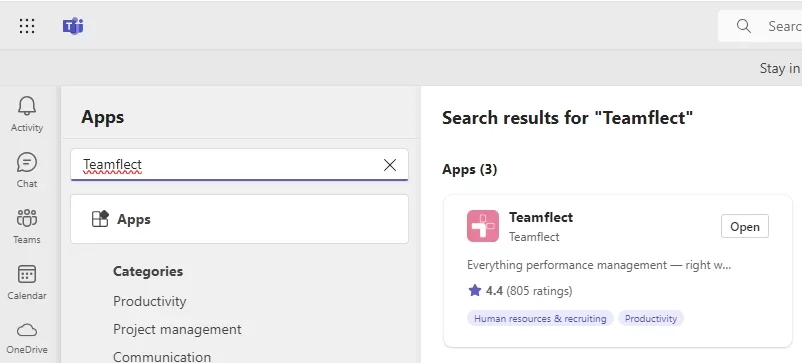
As the highest-rated meeting software and performance management tool in the Microsoft Teams ecosystem, Teamflect can be integrated into your Microsoft Teams with ease.
As an official Microsoft Partner, Teamflect does not require you to sign up, and can be accessed with your Microsoft Account.
Step 1: Using an integrated meeting software
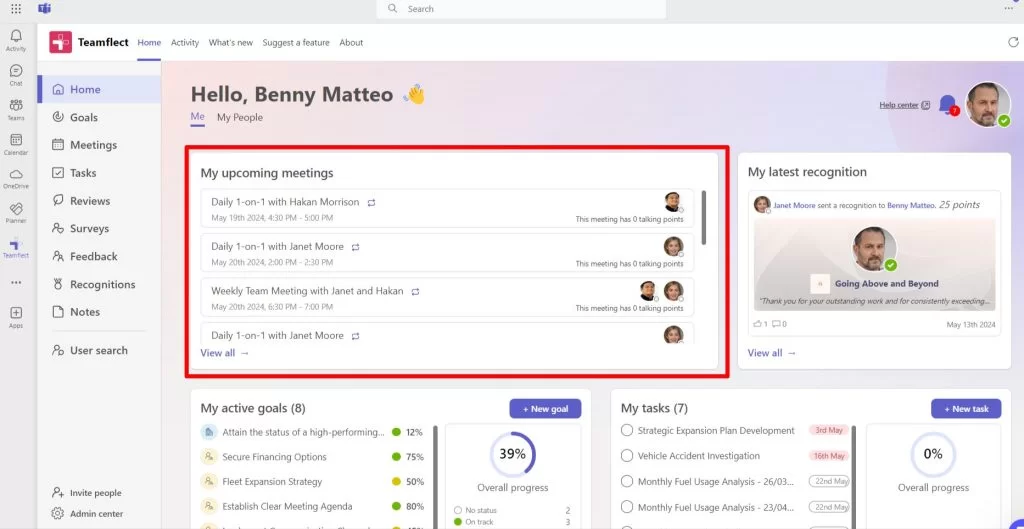
Drawing your meetings directly from your Outlook calendar, Teamflect displays them alongside all your other performance and employee management needs in an easy-to-navigate dashboard.
In order to start creating meeting agendas and integrating check-ins into your meetings, all you have to do is simply click on the meeting you want to prepare for.
Step 2: Creating a meeting agenda in Microsoft Teams
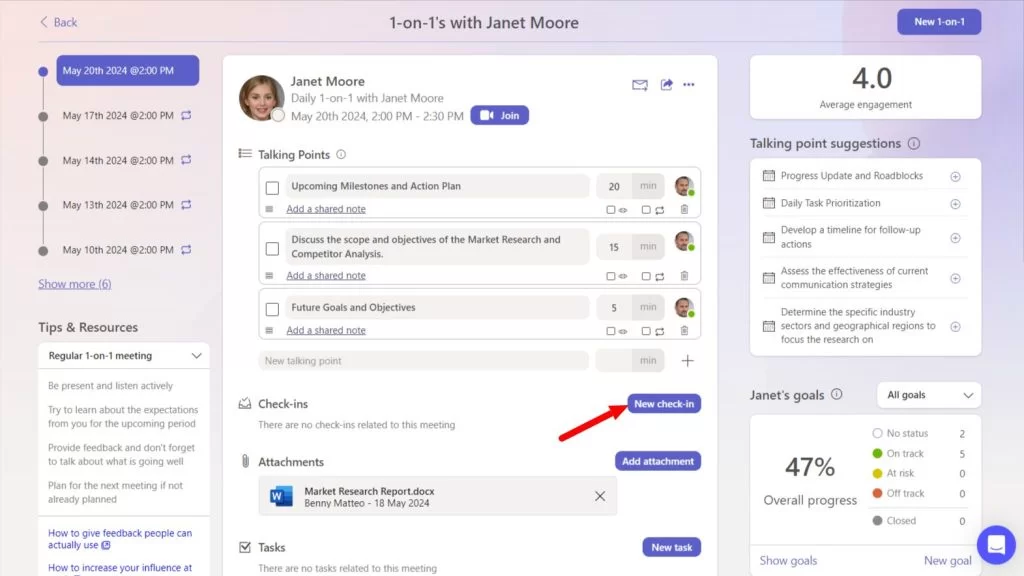
Once you access your Teams meetings, you will now see that the meeting page is now far more organized and structured than it was before, with an extensive array of new features and metrics available to you.
Inside the meeting page, you can easily create an agenda with detailed talking points. Teamflect will also offer some talking point suggestions based on your previous meetings and discussions.
Alongside talking points, you can also:
- Add a check-in template to your meeting
- Add attachments
- View the goal progress of everyone involved
- Create tasks
- Give feedback
- And more!
This also helps leaders preserve all necessary information about meetings, never letting any key talking points, meeting notes, or discussions disappear into the void. Instead, all agendas and meeting pages in a series of meetings can be easily accessed and edited.
While there are plenty of ways you can enhance your meetings, all you need to do to add a check-in template is to click the “New Check-in” button, as seen in the image above.
Step 3: Meeting check-in templates
Your next and final step will be to select the meeting check-in template that best serves your needs.
While Teamflect already has a library of check-in templates for you to choose from, create your own check-in template or customize existing ones.
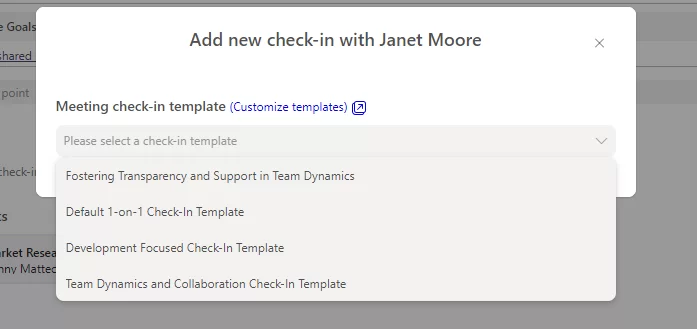
These templates can include various different question types based on what you as the leader are trying to gauge with them. Teamflect’s Microsoft Teams meeting templates have the following question types:
- Open-ended Questions
- Multiple Choice Questions
- Likert Scale
- Rating Questions
- People Picker Questions
Once you have selected the meeting check-in template that fits the occasion the best, all there is left to do is for the meeting participants to actually go through the check-in form and submit their answers.
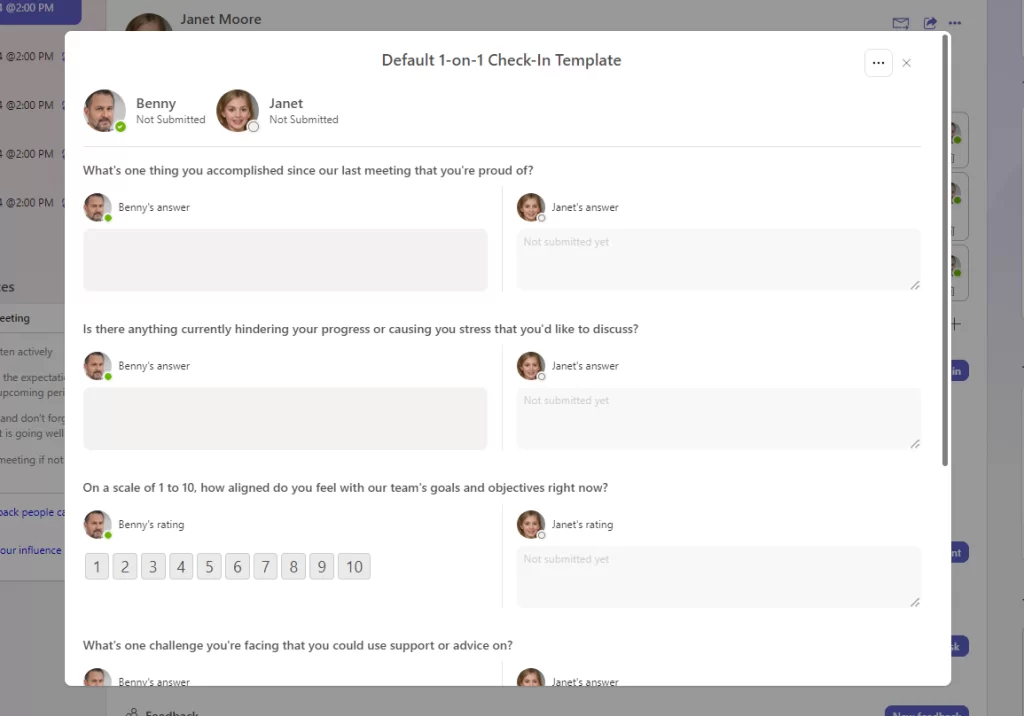
Meeting participants can complete these templates before, during, or after the actual meeting takes place.
If a manager so desires, they can actually make the completion of these check-in forms mandatory for employees to be able to access these meetings.
If you want to give this tool a try and start creating check-in templates for your meetings, we have some good news for you.
Teamflect is completely free with full-functionality for up to 10 users. No time or feature limitations!
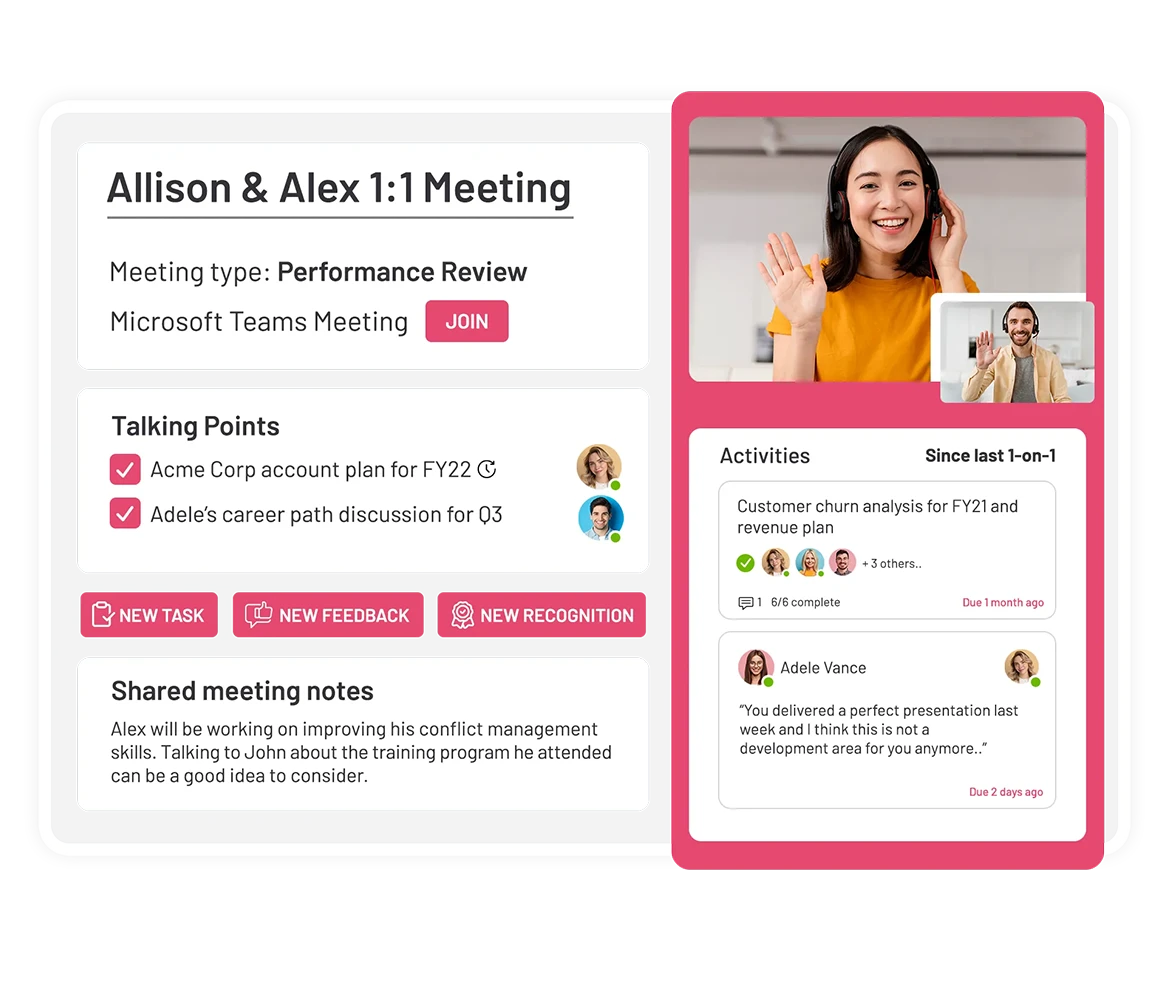
What are the benefits of using meeting check-in forms?
Regular meetings, regardless of whether the team is remote or not, require structure! Using a check-in template inside Microsoft Teams meetings not only provides teams with that necessary structure but also ensures communications are clear.
While the benefits we’ve highlighted below will depend heavily on what exactly you ask in those meeting check-in forms, here are some key benefits they offer:
1. Enhanced Preparation
Having a check-in form that participants need to complete before meetings ensures that they will come to the meeting prepared. Before the meeting even starts, participants can gather the necessary information, go through some of the updates they will be discussing in the meeting, and contribute to the discussions effectively.
Benefits:
- Ensures participants come prepared.
- Improves the quality of discussions.
- Enables more thoughtful and informed contributions.
2. Clearer Communication
A predefined template helps in setting clear communication expectations. Participants know what information they need to provide, which reduces ambiguity and improves the clarity of the information shared during the meeting.
Benefits:
- Promotes clear and concise communication.
- Reduces misunderstandings and miscommunication.
- Ensures everyone is on the same page.
3. Accountability and Follow-Up
An employee check-in questionnaire helps in documenting action items and responsibilities. It provides a written record of what was discussed and decided, which can be referenced in future meetings to track progress and ensure accountability.
Benefits:
- Provides a clear record of decisions and action items.
- Facilitates tracking of progress and accountability.
- Enhances follow-up on tasks and responsibilities.
What to include in a check-in meeting?
Moving away from the meeting templates and more into the actual content of the check-in meeting, let’s discuss just what exactly should be included when having a regular check-in meeting.
As we discussed in the previous section, this also depends heavily on the nature of your meetings as well as the meeting cadance you are following. What a leader should include in a weekly check-in will differ heavily from a daily stand-up or a monthly employee check-in.
Regardless, we’ve accumulated some general steps a regular employee check-in should follow in order to be effective.
One thing we will not include on this list however, are icebreakers! Why? Because we’ve made a list of all the best icebreaker and regular check-in questions you can ask in check-in meetings in another article! You can fire that one up right here: 200 Team Check-in Questions!
1. Review of Previous Action Items
The best way to start any check-in meeting is by discussing previous action items. It helps to ensure accountability and track progress. Ask team members to provide updates on their tasks and discuss any obstacles they may have encountered.
Sample Check-in Questions:
- “Can you update us on the status of your task from last week?”
- “Were there any challenges you faced while working on this?”
2. Current Project Status
The next step, which will vary depending on your teams structure and organizational nature is to discuss the current status of ongoing projects. Each team member should have the opportunity to share their progress, highlight milestones achieved, and note any delays or issues that need addressing.
Example Check-in Questions:
- “How is the project progressing according to the timeline?”
- “Are there any upcoming deadlines we should be aware of?”
3. New Tasks and Assignments
Once all the bases are covered, it is time to introduce and distribute new tasks and assignments. Going through this step openly as a group encourages active participation and ensures everyone is crystal clear on what is expected of them.
4. Open Discussion and Feedback
Provide an open forum for team members to discuss any issues, ideas, or feedback they may have. This can include anything from process improvements to team dynamics. Encourage a culture of open communication where everyone feels comfortable sharing their thoughts.
Example Prompts:
- “Does anyone have any feedback or suggestions for improving our workflow?”
- “Are there any roadblocks or concerns that we haven’t addressed?”
5. Next Steps and Meeting Recap
Conclude the meeting by summarizing the key points discussed and outlining the next steps. Clearly define any new action items and assign responsibilities. This helps to reinforce what was discussed and ensures everyone leaves the meeting with a clear understanding of their tasks.
Ready to take your meetings to the next level?
If you’ve stuck around with this article until the very end, it means you really care about having productive and engaging meetings with your team. Having regular and structured check-ins is the best way to ensure your direct reports are aligned and communicating effectively.
Whether you are having meetings with your direct reports one-on-one or conducting team check-ins over Microsoft Teams, creating detailed meeting agendas and having meeting check in templates at your disposal is an undeniable benefit to both you and your team.
To learn more about the highest-rated performance management platform in the Microsoft Teams app store, you can always schedule a quick demo with our team!



